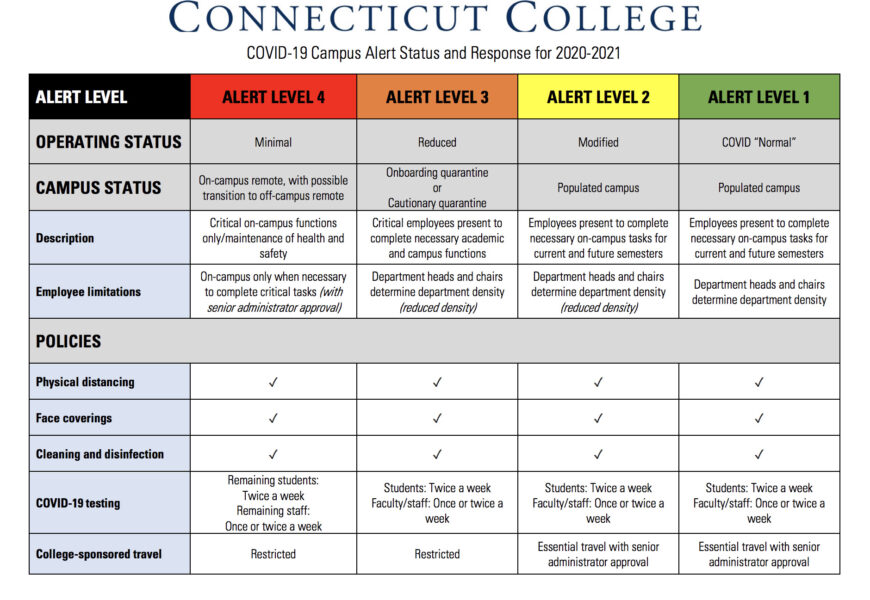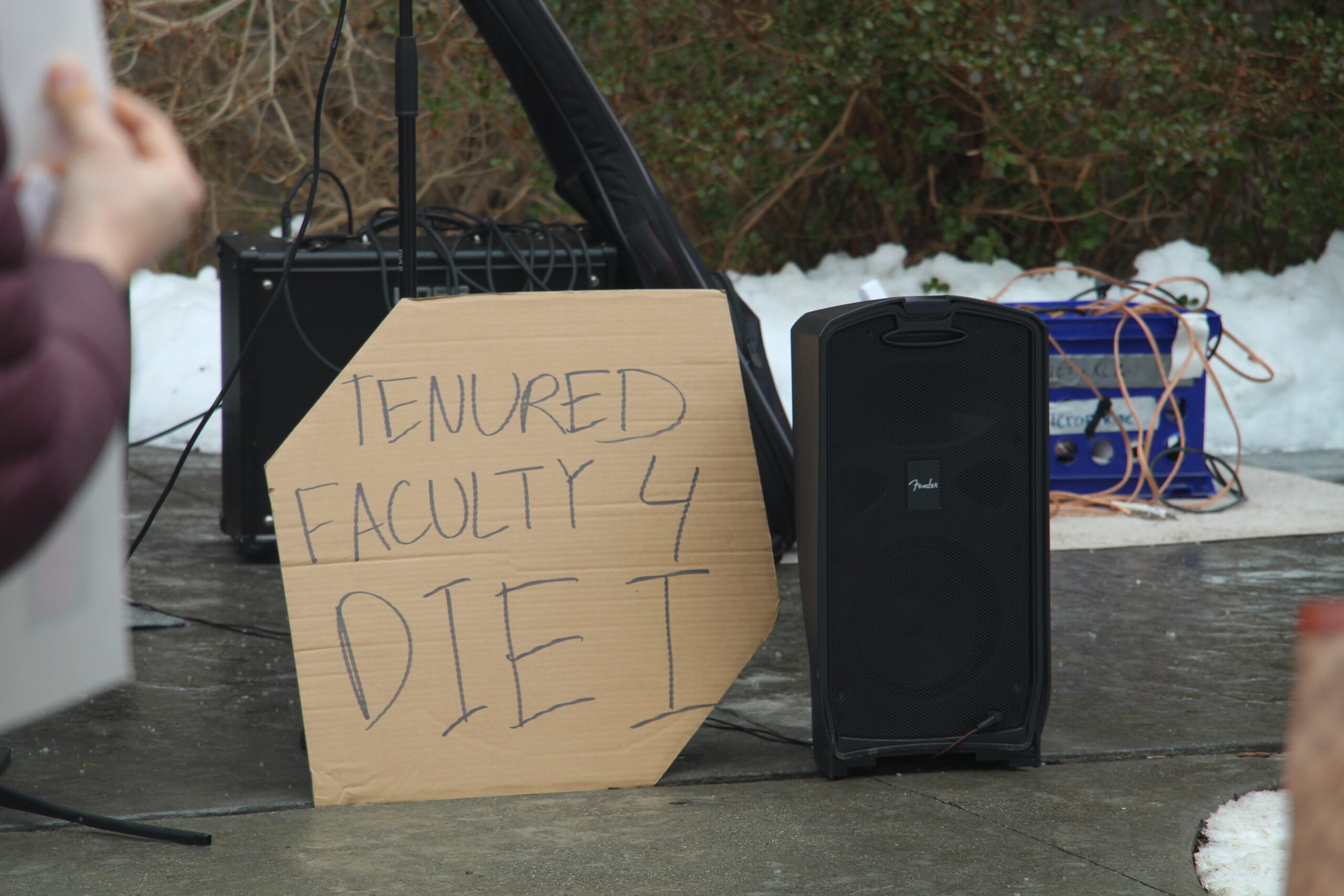Photo courtesy of Connecticut College
This fall semester has been a big change for all of us, and no I am not talking about the changing of seasons. Since March, colleges and universities have raised the question of what the fall semester would look like during a global pandemic. However, institutions have different ideas about the best way to go about learning due to certain factors and the challenges that they face. Whether the semester is all online, all in person, or mixed, this new normal sparked uncertainty regarding campus life in Fall 2020.
One of the most ambitious reopening plans is taking place at the University of California, San Diego. According to its website, the school introduced a new program, titled ‘Return to Learn.’ The program began in early May, providing tests to around 5,000 students that were still on campus for the spring semester (with the number of students and tests later expanding into the fall semester). Like Connecticut College, students are required to go to an assigned testing site to swab their noses, and samples will then be collected from a drop box. However, the University of California of San Diego has a significantly larger population of about 65,000 people (students, faculty, staff) they plan to test at least twice a month with no more than 16 days between tests. Strict rules for social distancing are also taking place; for example, all resident halls will be limited to one student per room, no visitors allowed, and out of the 4,750 course offerings, and as stated by their website, only “12 percent of Fall 2020 courses [will be] using an in person or hybrid modality.” Remaining courses will be held remotely.
The reopening plan of UC of San Diego is just one of many schools nationwide that is basing their reopening plans around one crucial decision: financial stability. As stated in the Report of the Higher Education Subcommittee to Reopen Connecticut, if higher education institutions wanted to pursue in-person classes, “colleges and universities must be financially able to provide, administer, and process diagnostic tests,” with an estimation of “between 200,000 and 300,000 tests” needed in late August and early September, plus an additional quantity of tests and the cost of extra safety precautions.
According to USA Today, The American Council on Education estimates that it would cost at least $73.8 billion in new costs to reopen campuses nationwide. This creates a huge financial risk for schools and a big commitment, especially for tuition-dependent private colleges and universities. In a New York Times article, the president of Brown University, Christina Paxson, writes that “most colleges and universities are tuition dependent,” meaning that “remaining closed in the fall means losing half of our revenue.” For some schools, the solution to that problem means letting at least some students live on campus to bring in a fraction of the funds, rather than no funds at all when going totally remote.
On the other hand, bigger and more well-known universities would be able to survive an all-online semester since they have larger funds and more donors. The Chronicle of Higher Education conducted a study with Davidson College’s College Crisis Initiative, in which it surveyed schools across the country about what their reopening plans were for the fall semester. Accordingly, private, non-profit, and four-year schools were more likely to be in-person while larger, public, four-year schools are mostly online. Furthermore, out of the top twenty richest US schools in 2019, only seven are primarily in-person or hybrid, making the majority online.
Additionally on a smaller-school scale, colleges that are part of the North England Small College Athletic Conference (NESCAC), also seem to be split on the decision of how to reopen the fall semester. One factor could be the influence of their respective governors’ guidelines to reopening the state and the status of Covid cases and hospitalization rates in the surrounding community. Moreover, using the The Chronicle of Higher Education database, out of the 11 NESCAC schools, 2 schools are primarily online, 4 schools are primarily in person, and 5 schools are hybrid. Dean of the College Jefferson Singer, who was involved in designing the plan to bring students back, answered questions that I had through a Google Form about collaborating with other NESCAC schools on what is the best way to reopen. “Both the Dean of the Faculty and I participate in a weekly Zoom meeting with the other chief NESCAC academic officers,” Dean Singer wrote on Sept. 17th, “so we are in very close communication with our peer institutions.” When asked whether or not these plans, when compared to other schools, were more similar or different, Singer writes, “Some of these institutions chose to bring back only a portion of their classes (for example, Bowdoin) and others have plans similar to ours (for example, Hamilton, Trinity and Wesleyan).”
However, no matter how thought out a plan for reopening is, there is still a risk that it could fail. SUNY Oneonta already moved to full online learning after having one of the worst Covid-19 outbreaks at a university nationwide, with a total of 687 positive tests as of Sept. 26th. While looking at the reopening plan that SUNY Oneonta posted on their website, there were some aspects that raised concerns for me. One of which was the lack of testing being done on asymptomatic students. The plan stated that “students are not required to get tested” before arriving on campus, and that the campus would solely focus on testing students with symptoms, while those that are asymptomatic would be “pooled tested” once per week. However, according to The New York Times, students, parents, and faculty reported that the school did not test students at all once they arrived on campus. Another concern was the lack of enforced social distancing rules on the campus. In their plan, the school states that “it’s a shared responsibility” to not gather in groups, expecting students to take a pledge titled “Statement of Shared Responsibility” without going more into details. However, in that same New York Times article, the school “did not closely prevent gatherings in off-campus gatherings.” One college student at SUNY Oneonta stated that the school “relied too heavily on students maintaining social distance on their own” rather than surveilling the campus in order to prevent possible parties.
While the cases at SUNY Oneonta most visibly failed to prevent the spread of Covid-19, time will tell if Connecticut College can avoid the same fate. It is hard to tell which reopening plan will be deemed the most successful and if schools will be able to successfully complete the semester in person. But for now, it is important to collectively follow the health guidelines of social distancing and wearing a mask until all college students can return to campus again.•










